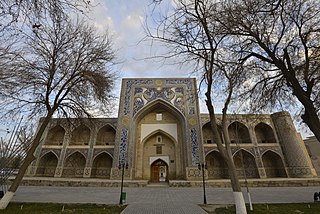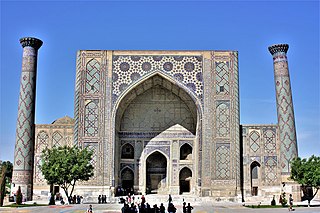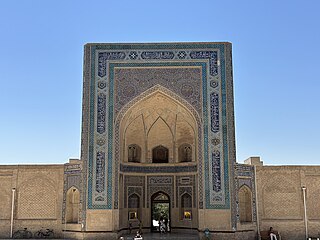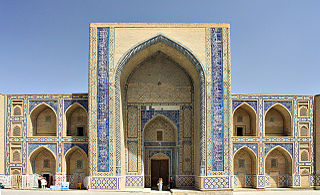The Abdulaziz-Khan Madrasah is an ancient madrassah in Bukhara, Uzbekistan. Like the entire historic part of the city, it is listed as a UNESCO world heritage site. It owes its name to its founder, Abdulaziz Khan (1614-1683) who had it built in 1652-1654. It is part of an architectural ensemble, forming a koch (double) with the Ulugbek Madrasah (1417), located to the east of the jewelers' bazaar. Its exterior decoration is partly unfinished, because the Khan was dethroned while the decoration of the madrassah was not yet finished and the architect put an end to the project.
The external portal, or Pishtaq, as well as the portals opening onto the interior courtyard are covered with blue and yellow tiles (this bright yellow being used for the first time in Bukhara) where we find traditional motifs, such as the vase of happiness.
The madrasah is decorated with mosaics, relief majolica, glazed tiles, chiseled marble, alabaster frescoes, gantch (chiseled wood) and gold leaf. It is therefore a masterpiece of the Central Asian architectural art. One can notice, contrary to the Islamic architectural tradition, figurative representations and greater realism of floral and plant decoration. In addition to the cells and shared areas, the madrassah includes a small winter mosque and a summer mosque.
The madrasah also has fireplaces, which was an innovation for the time.
Today, the Abdullaziz-Khan Madrasah houses souvenir, fabric and carpet shops.

Qarshi is a city in southern Uzbekistan. It is the capital of Qashqadaryo Region. Administratively, Qarshi is a district-level city, that includes the urban-type settlement Qashqadaryo. It has a population of 278,300. It is about 520 km south-southwest of Tashkent, and about 335 km north of Uzbekistan's border with Afghanistan. It is located at latitude 38° 51' 48N; longitude 65° 47' 52E at an altitude of 374 meters. The city is important in natural gas production, but Qarshi is also famous for its production of woven flat carpets.

Samarkand or Samarqand is a city in southeastern Uzbekistan and among the oldest continuously inhabited cities in Central Asia. Samarqand is the capital of Samarqand Region and a district-level city, that includes the urban-type settlements Kimyogarlar, Farhod and Khishrav. With 551,700 inhabitants (2021), it is the third-largest city of Uzbekistan.

Bukhara is the seventh-largest city in Uzbekistan by population, with 280,187 residents as of 1 January 2020. It is the capital of Bukhara Region.

Khiva is a district-level city of approximately 93,000 people in Khorazm Region, Uzbekistan. According to archaeological data, the city was established around 2,500 years ago. In 1997, Khiva celebrated its 2500th anniversary. It is the former capital of Khwarezmia, the Khanate of Khiva, and the Khorezm People's Soviet Republic. Itchan Kala in Khiva was the first site in Uzbekistan to be inscribed on the World Heritage List (1991). The astronomer, historian and polymath, Al-Biruni was born in either Khiva or the nearby city of Kath.

The Registan was the heart of the city of Samarkand of the Timurid Empire, now in Uzbekistan. The name Rēgistan (ریگستان) means "sandy place" or "desert" in Persian.

Lab-i Hauz, sometimes also known as Lyab-i Khauz, a Russian approximation, is the name of the area surrounding one of the few remaining hauz pools that have survived in the city of Bukhara, Uzbekistan. Until the Soviet period, there were many such pools, which were the city's principal source of water, but they were notorious for spreading disease and were mostly filled in during the 1920s and 1930s.

Po-i-Kalan, or Poi Kalan, is an Islamic religious complex located in Bukhara, Uzbekistan. The complex consists of three parts, the Kalan Mosque, the Kalan Minaret to which the name refers, and the Mir-i-Arab Madrasah. The positioning of the three structures creates a square courtyard in its center, with the Mir-i-Arab and the Kalan Mosque standing on opposite ends. In addition, the square is enclosed by a bazaar and a set of baths connected to the Minaret on the northern and southern ends respectively.

The Great Mosque of Adana, also known as the Ramazanoglu Mosque, is a 16th-century mosque in Adana, Turkey. It forms part of a complex (külliye) that includes a madrasah and a mausoleum (türbe). The complex is on Kızılay street, next to the Ramazanoğlu Hall.

Chor-Bakr is a memorial complex in the village of Sumitan at 5 km of Bukhara in Uzbekistan, built over the burial place of Abu-Bakr-Said, who died in the year 360 of the Muslim Calendar, and who was one of the four of Abu-Bakrs (Chor-Bakr) – descendants of Muhammad. The complex includes the necropolis of family tombs, and courtyards enclosed with walls.

The Ulugh Beg Madrasa is a madrasa in the historic center of Samarkand, a UNESCO World Heritage Site in Uzbekistan. Together with other monuments, it forms the monumental ensemble of Registan, the old heart of the city. It was built between 1417 and 1421 by the then-Timurid governor of Samarkand, Ulugh Beg, Timur's grandson and prominent astronomer, who was later emperor between 1447 and 1449.

The architecture of Uzbekistan combines ancient traditional design and innovative features adapted to the climate. Centers of Uzbek architecture are Samarkand, Bukhara, Khiva, Shakhrisabz, Termez, and Kokand. A number of ancient architectural masterpieces have survived, including palaces, mausoleums, mosques, and minarets. Colorful mosaics, religious symbols, and abstract geometrical patterns also characterize architecture in Uzbekistan.

Chor Minor, alternatively known as the Madrasah of Khalif Niyaz-kul, is a historic gatehouse for a now-destroyed madrasa in the historic city of Bukhara, Uzbekistan. It is located in a lane northeast of the Lyab-i Hauz complex. It is protected as a cultural heritage monument, and also it is a part of the World Heritage Site Historic Centre of Bukhara. In Persian, the name of the monument means "four minarets", referring to the building's four towers.

The Khoja-Gaukushan Ensemble is one of the largest architectural complexes in the center of Bukhara. Along with a number of other buildings in central Bukhara, it is included in the UNESCO World Heritage List.
Subhan Quli Khan (1625–1702) was the sixth ruler of the Bukhara Khanate, who reigned from 1681 to 1702.

Kalan Mosque is an architectural monument located in Bukhara, Uzbekistan. It was considered one of the largest mosques built on the place of Jame' Mosque. Its current appearance was built in 1514 during the reign of Shaybani Ubaidullah Khan of Bukhara. Currently, the mosque is included in the national list of estate real objects of material and cultural heritage of Uzbekistan.

Abdullakhan madrasah is an architectural monument located in the north of the Koshmadrasa ensemble in Bukhara, Uzbekistan. This madrasah, which is a perfect example of the architecture of the Uzbek ruler Abdullah II, demonstrates all the creative achievements of Bukhara architecture in the 16th century.

Joybori Kalon Madrasah is located in Bukhara, Uzbekistan. During the reign of the Uzbek ruler Abdulaziz Khan (1645-1681), it was built in Havzi nav guzar of Joybor district in the capital of the Khanate under the donation of his mother Podshah. It was one of the most prestigious and prestigious madrasahs in Bukhara.

Modarikhan Madrasah is an architectural monument (1566-1567) located opposite the Abdullah Khan Madrasah in Bukhara. Both make up the Koshmadrasa complex. Abdullakhan Madrasah (Bukhara) is located opposite. Currently, it is included in the national list of real estate objects of material and cultural heritage of Uzbekistan.39.77447717366°N 64.40592327683°E

Nadir Devanbegi Madrasah is an architectural monument in Bukhara, Uzbekistan. It was built between 1622 and 1623 by Nadir Devanbegi, the minister of Bukhara Khan, Imam Quli Khan. Nadir Devonbegi madrasah is located in the old city of Bukhara. It is located in the eastern part of the Lyab-i Hauz. Currently, the madrasah is included in the national list of immovable property objects of the material and cultural heritage of Uzbekistan.

Ulugbek madrasah is an architectural monument (1417) in Bukhara, Uzbekistan. It is the oldest preserved madrasah in Central Asia. It is the oldest of the madrasahs built by Ulugbek. During the reign of Abdullah Khan II, major renovation works were carried out (1586).